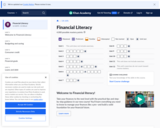
Find services for a variety of services IN YOUR AREA.
You can: call, text or web chat.
- Subject:
- Education
- Indigenous Perspectives
- Material Type:
- Primary Source
- Date Added:
- 12/07/2018

Find services for a variety of services IN YOUR AREA.
You can: call, text or web chat.

Differentiate between buying, renting, and leasing.
Teacher Guide included.
3-5 hours

Students explore the many different ways that engineers provide natural lighting to interior spaces. They analyze various methods of daylighting by constructing model houses from foam core board and simulating the sun with a desk lamp. Teams design a daylighting system for their model houses based on their observations and calculations of the optimal use of available sunlight to their structure.

Students investigate circuits and their components by building a basic thermostat. They learn why key parts are necessary for the circuit to function, and alter the circuit to optimize the thermostat temperature range. They also gain an awareness of how electrical engineers design circuits for the countless electronic products in our world.

We all know that it takes energy to provide us with the basics of shelter: heating, cooling, lighting, electricity, sanitation and cooking. To create energy-efficient housing that is practical for people to use every day requires combining many smaller systems that each perform a function well, and making smart decisions about the sources of power we use. Through five lessons on the topics of heat transfer, circuits, daylighting, electricity from renewable energy sources, and passive solar design, students learn about the science, math and engineering that go into designing energy-efficient components of smart housing that is environmentally friendly. Through numerous design/build/analyze activities, students create a solar water heater, swamp cooler, thermostat, model houses for testing, model greenhouse, and wind and water turbine prototypes. It is best if students are concurrently taking Algebra 1 in order to complete some of the worksheets.

"Take your finances to the next level with the practical tips and step-by-step guidance in our new course! You’ll learn everything you need to know to manage your finances like a pro—and build a solid foundation for your financial future."
Learn the 101 of Financial Literacy for free with these 12 units.
*Unit 11 is full of teacher resources.

Students explore heat transfer and energy efficiency using the context of energy efficient houses. They gain a solid understanding of the three types of heat transfer: radiation, convection and conduction, which are explained in detail and related to the real world. They learn about the many ways solar energy is used as a renewable energy source to reduce the emission of greenhouse gasses and operating costs. Students also explore ways in which a device can capitalize on the methods of heat transfer to produce a beneficial result. They are given the tools to calculate the heat transferred between a system and its surroundings.

Through an introduction to the design of lighting systems and the electromagnetic spectrum, students learn about the concept of daylighting as well as two types of light bulbs (lamps) often used in energy-efficient lighting design.

Students learn and discuss the advantages and disadvantages of renewable and non-renewable energy sources. They also learn about our nation's electric power grid and what it means for a residential home to be "off the grid."

The following file contains the assets (or resources) to accompany the Sask DLC Life Transitions 30. Please note that this is not the content of the course, but the assets used to support and deliver it. The files are organized in a zipped folder. You can download it and extract the files. Links are also provided to other materials like videos and other suggested resources. life

Students are introduced to passive solar design for buildings an approach that uses the sun's energy and the surrounding climate to provide natural heating and cooling. They learn about some of the disadvantages of conventional heating and cooling and how engineers incorporate passive solar designs into our buildings for improved efficiency.

Student teams design and build solar water heating devices that mimic those used in residences to capture energy in the form of solar radiation and convert it to thermal energy. This thermal energy is next transferred to water (to be used as domestic hot water) in the form of heat. In doing this, students gain a better understanding of the three different types of heat transfer, each of which plays a role in the solar water heater design. Once the model devices are constructed, students perform efficiency calculations and compare designs.

Using a household fan, cardboard box and paper towels, student teams design and build their own evaporative cooler prototype devices. They learn about the process that cools water during the evaporation of water. They make calculations to determine a room's cooling load, and thus determine the swamp cooler size. This activity adds to students' understanding of the behind-the-scenes mechanical devices that condition and move air within homes and buildings for human health and comfort.

Students investigate passive solar building design with a focus solely on heating. They learn how insulation, window placement, thermal mass, surface colors, and site orientation play important roles in passive solar heating. They use this information to design and build their own model houses, and test them for thermal gains and losses during a simulated day and night. Teams compare designs and make suggestions for improvements.